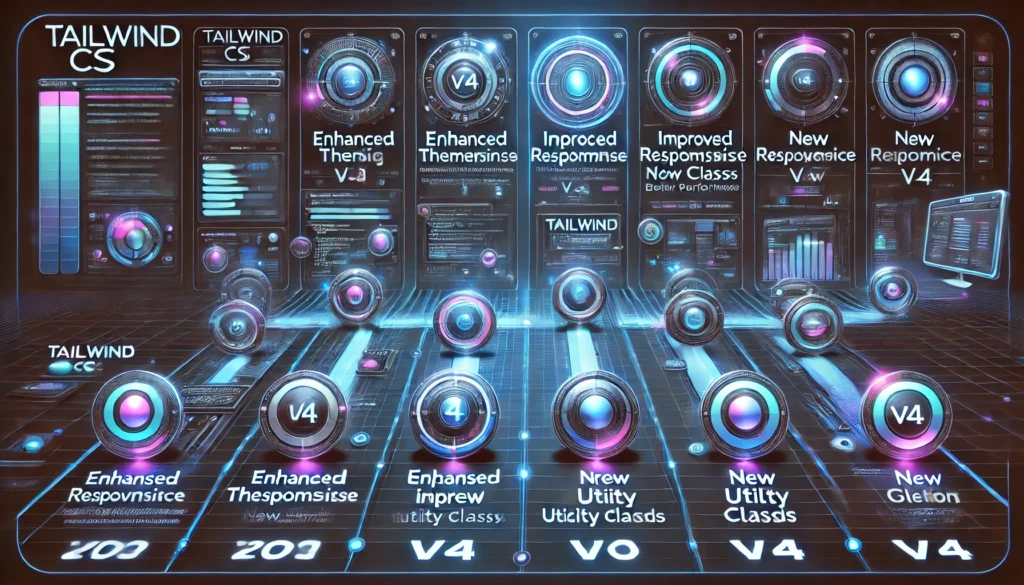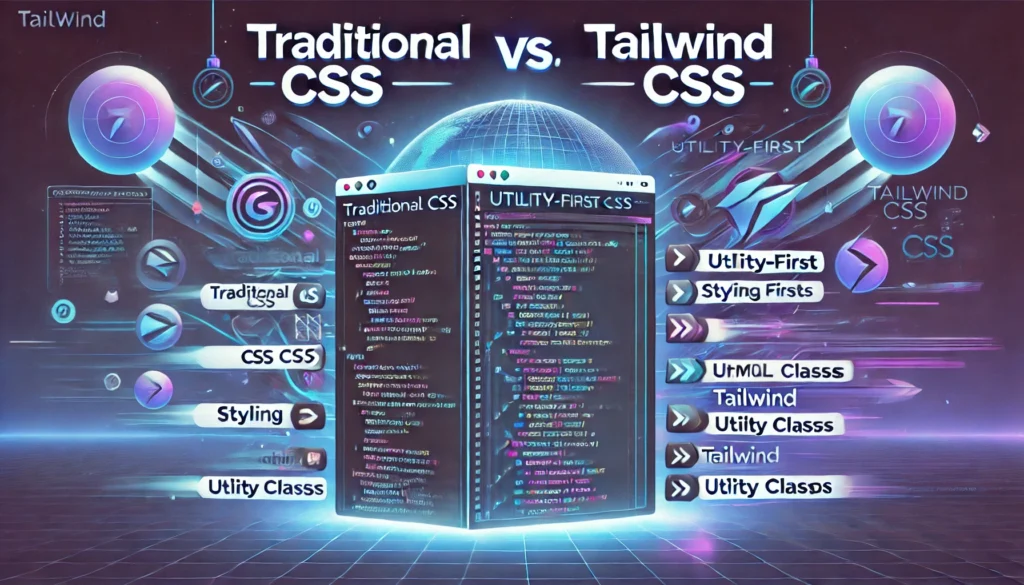Progressive Web Apps, or PWAs, have emerged as one of the most transformative developments in modern web technology. They combine the accessible nature of websites with the powerful capabilities often associated only with native mobile applications. This hybrid identity grants them the unique ability to be installed on a user’s home screen and function efficiently whether the user is online or offline. Although PWAs and native apps may appear similar in many ways, the true hallmark of a PWA lies in its simplicity of distribution, service worker functionalities, and responsiveness across an array of devices. These traits have catapulted PWAs into the spotlight, creating a new standard for how brands and developers approach their online presence and user engagement strategies.
One of the most fascinating features of a PWA is how seamlessly it can adapt to multiple environments while retaining a consistent interface. Rather than requiring publication through official app stores, these applications can be shared via direct URLs or added to a device’s home screen from a website prompt. This open-ended accessibility breaks down longstanding barriers, making advanced, app-like experiences far more attainable for businesses, entrepreneurs, and content creators of all sizes. Instead of designing entirely separate mobile, desktop, or native experiences, developers can craft a single PWA that gracefully scales to meet specific user contexts. The result is a fluid approach to functionality that is just as at home on a tablet as it is on a smartphone or a laptop.
PWAs excel in bridging the gulf between conventional websites and full-fledged native apps, largely through a combination of service workers, manifest files, and responsive design principles. The service worker acts like the silent backbone of a PWA, caching essential assets, intercepting network requests, and enabling offline functionality. The application manifest defines how the PWA will appear on a device, such as its icon and splash screen, while ensuring it can be installed similarly to a native app. Together, these parts empower PWAs to operate more independently of real-time network connectivity. Users can continue reading articles, browsing products, or completing tasks even if their internet signal is dropped. This reliability and speed fosters an environment where the application feels more like a standard, self-contained tool and less like a webpage tethered to a constant data stream.
PWAs further distinguish themselves by making use of push notifications, camera access, geolocation, and other hardware-level features typically reserved for native apps. Although there are certain restrictions based on device operating systems, the support for these capabilities continues to grow. This indicates that PWAs are evolving into a truly universal format that can deliver all the hallmarks of a native app — interactivity, immersion, and consistent branding — without the friction of store submissions or version fragmentation. It is no longer necessary to juggle separate iOS and Android builds, each requiring distinct maintenance. A properly structured PWA can bring broad coverage and uniformity to user experiences, all while maintaining a central codebase that can be updated instantly in the background.
PWAs mimic native app experiences so effectively that many users may not even realize they are using a web-based application. Once they have pinned the PWA’s icon to their home screen, they can launch it directly. It appears in a standalone window, showing no browser UI elements, and can store data locally, thereby ensuring content remains accessible even when the device is offline. This consistency is a core value for developers who aim to meet users’ modern expectations of speed and reliability. Rather than opening an unwieldy website in a browser each time, the PWA cuts the clutter and focuses on giving users a sleek, app-like portal to services. In turn, user satisfaction often rises as they experience fewer slowdowns and appreciate the minimal friction needed to re-engage with a particular platform.
Below is a simple graphics element that shows the conceptual flow of how a PWA utilizes caching, installation prompts, and offline storage to deliver app-like performance. While the exact design may vary, this illustration underscores the architecture behind PWAs, wherein a service worker stands at the heart of offline support, pushing performance gains and bridging the network gap.
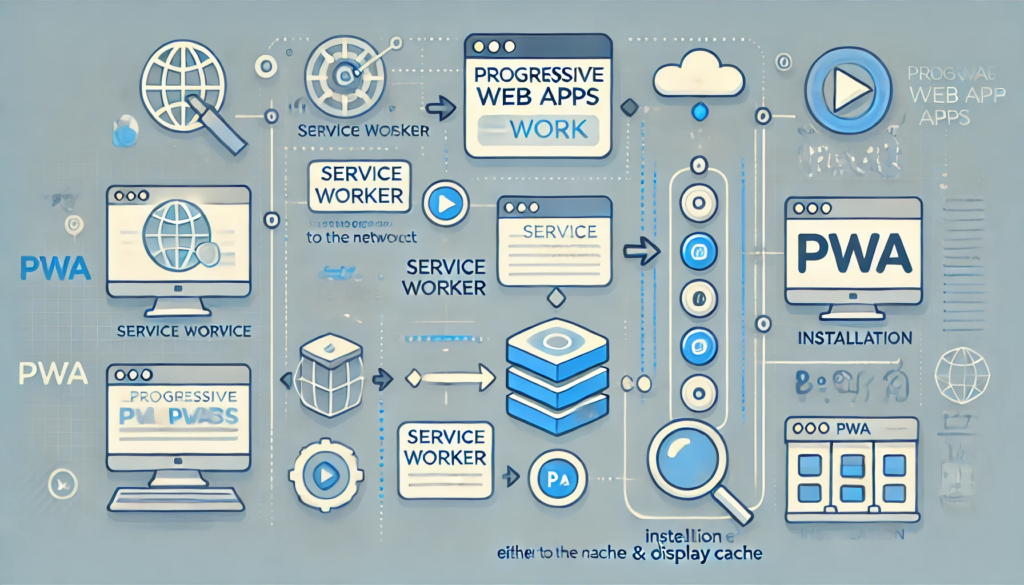
When considering how PWAs can stand toe-to-toe with native apps, it is important to remember that modernization strategies are still ongoing. Some older devices or browsers offer partial support, limiting certain hardware APIs. Nevertheless, leading browsers have been quick to adopt progressive web technologies, and it is becoming more common to see features like Web Push, advanced offline caching, and camera APIs accessible through JavaScript. For businesses committed to forging a powerful online identity, PWAs represent a cost-effective and future-proof method of reaching audiences without alienating potential users who might prefer not to download a full-scale native app.
A web development studio that has embraced the PWA approach can drastically reduce the fragmentation typically experienced when building separate codebases for different platforms. This also allows for more agile updates and version rollouts, since changes made to the single code repository propagate seamlessly across all endpoints. The moment a user visits or reopens the PWA, they can benefit from the latest features and security improvements without performing manual updates. By taking advantage of caching and service worker rules, returning visitors can also enjoy faster load times, as much of the essential data and resources are already stored on their device.
PWAs bridge the gap for developers seeking simplified solutions and users expecting high-speed, immersive, and reliable applications. With each iteration of web standards, the lines between “web” and “app” get blurrier, as more hardware-level capabilities become accessible via browser technologies. Market research indicates that an increasing number of businesses from small startups to established brands are turning to PWAs to boost engagement, reduce bounce rates, and deliver uniform cross-platform experiences. These benefits are often tangible in the form of higher time spent on site, improved conversions, or greater brand loyalty, as users become accustomed to seeing that small icon on their home screen, ready for use at a moment’s notice.
Despite these advantages, the transition to a PWA cannot be taken lightly. It demands thorough planning, meticulous design, and consistent testing across a wide variety of environments. Developers must craft their service worker logic carefully to ensure that offline states are handled correctly and that updates are rolled out smoothly. Keeping assets optimized for caching can become an art in itself, especially for content-heavy platforms that serve images, videos, or interactive modules. Nonetheless, the payoff is substantial, as a fully realized PWA allows businesses to provide a near-native experience that is frictionless and always at the user’s fingertips.
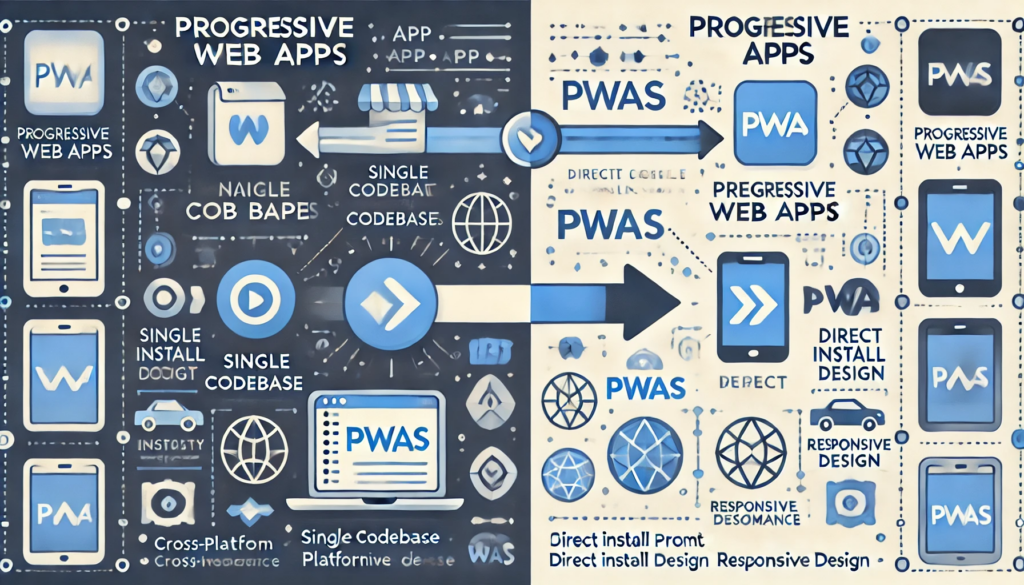
Modern design philosophies like mobile-first and responsive layouts dovetail neatly with PWA development, ensuring that content is both visually appealing and functional on any device. This synergy empowers brands to develop deep connections with their audiences through fluid, device-agnostic experiences. By continuously refining the manifest, icon sets, splash screens, and offline modes, businesses can maintain a consistent brand identity that looks polished whenever a user opens the PWA. This visually pleasing approach, coupled with swift load times, fosters a sense of trust and credibility in the brand. Users rarely suspect that these benefits emerge from web technologies rather than a heavy native codebase.
A notable challenge in adopting PWAs revolves around discoverability in app stores. While certain platforms now offer ways to list PWAs in their native stores, the road to a fully integrated approach is still evolving. Nevertheless, the ease of distribution through URLs can be considered a significant plus for marketing campaigns, viral sharing, and universal access. With a single link, a potential user can discover the PWA, explore its features in a browser, and optionally install it as an icon on their device. From a user-experience perspective, the friction is minimal, and the curiosity factor is high since the user invests minimal time in testing the PWA’s functionality. If they find it appealing, they can add it to their home screen instantly without sifting through a marketplace or logging into an app store account.
In terms of user engagement, push notifications stand out as an especially compelling feature, bridging the real-time engagement typical of native apps with the accessibility of the web. By sending timely, relevant notifications, businesses can pull users back into the app and encourage continuous interaction. This functionality hinges on secure connections (HTTPS) and a thorough permissions model, ensuring that only users who opt-in receive updates. Because these notifications operate much like those from any other native app, they can lead to significantly improved retention when used responsibly and with clear user consent. These success factors indicate the importance of well-planned user journeys and notification strategies that place genuine value in front of the recipient.
Security is another critical factor. Since PWAs rely on service workers, they must be served over HTTPS to guarantee data integrity and user trust. This secure foundation often forms the backbone for enabling advanced capabilities. As a result, PWA developers generally adopt modern security practices to ensure that their applications not only run smoothly but also protect user data. Browsers enforce these standards strictly, leading to safer experiences for everyone involved. This aspect ties back to brand reputation: trusting a web application with personal data or consistent usage requires an assurance that security is treated as a priority rather than an afterthought.
The reason behind the growing adoption of PWAs is not merely user convenience. On the business side, it can be more cost-effective to maintain and update a single PWA codebase instead of multiple native apps. This approach can significantly reduce the resources spent on developing for different platforms and handling the intricacies of app store releases. Additionally, the agility of rolling out updates in real time means that users always access the latest version of the application. This quick iteration cycle can help businesses respond rapidly to user feedback or market changes, pivoting features or designs without encountering the delays or limitations of traditional app store approvals.
PWAs have also created new possibilities for content delivery. Media publishers, news websites, and eCommerce platforms have leveraged offline reading modes, quick re-engagement prompts, and push notifications to keep customers in the loop. This is particularly advantageous in areas with slower networks or limited connectivity, where offline functionality can be a game-changer. Being able to continue reading an article or browsing a product catalog despite spotty signals builds goodwill and can be the deciding factor in whether a user stays loyal to a brand or moves on to a competitor’s offering.
PWAs are not intended to entirely replace native apps, but rather to supplement or, in certain scenarios, offer an alternative path that combines the best of both worlds. For companies deeply invested in native platforms or those offering complex functionalities reliant on unique platform APIs, continuing with a dedicated native strategy might still be essential. However, for many enterprises and individuals who require an agile, universally compatible, and straightforward approach to reaching audiences, PWAs deliver on every front. They remove much of the friction of app distribution, provide offline access and push notifications, and can mirror native performance under typical usage conditions.
There are still challenges, such as constraints on certain advanced hardware APIs or differences in how various platforms handle installation prompts. Yet, the direction is clear: PWAs keep moving forward to offer more robust capabilities with each major browser release. As businesses weigh the pros and cons of going fully native or adopting a web-first approach, PWAs often emerge as a compelling solution that harmonizes cost, coverage, and performance.
Modern marketing initiatives already reflect this trend, as digital ad campaigns and social media promotions become more aligned with deep-linking directly to app experiences. The difference is that, with a PWA, the user can instantly experience the service, then decide to install it if they find it valuable. The short path from exposure to engagement fosters organic growth and strong user retention. Building these experiences requires a blend of design, development, and strategy. By focusing on aspects like load speed, interactive transitions, and user flows, developers can craft an app-like environment that feels alive under the user’s fingertips.

Now is the perfect time to seize this opportunity. If you want to ride the wave of the future, partnering with a skilled web development studio is essential. This is where Vadimages comes in. Our team of experts is passionate about leveraging the potential of Progressive Web Apps to elevate your online presence, branding, and user experiences. Whether you run an emerging startup or an established enterprise, our mission is to provide tailored PWA solutions that resonate with your goals, spark engagement, and turn casual visitors into loyal users. At Vadimages, we believe in the transformative power of technology when harnessed through thoughtful design and development. Our portfolio reflects a commitment to delivering smooth interactions, intuitive interfaces, and reliable performance for your PWA projects.
In an era where attention spans are short and user demands are high, striking that perfect balance between native app convenience and web-based flexibility is no small feat. The rise of PWAs brings us closer than ever to achieving that harmony. Whether it’s offline capabilities, lightning-fast load times, or frictionless installations, PWAs underscore the next wave of digital experiences that empower users to connect with brands anywhere, anytime. They represent a shift toward a more inclusive internet, one that doesn’t require specialized hardware or store logins to gain full functionality. Instead, it invites any user with a modern browser to step into an app-like dimension of speed, immersion, and convenience.
Developers, designers, and businesses that embrace PWAs early often discover new ways to foster user loyalty, trim operational inefficiencies, and spark product innovation. By observing how major tech companies and pioneering startups employ progressive web technologies, we see that pushing boundaries is not only feasible but also surprisingly accessible. From eCommerce shops that enable frictionless checkouts to dynamic news portals that keep content fresh even in airplane mode, the scope of PWA applications is as broad as the web itself. And while the technology continues to evolve, each improvement only sharpens the competitive advantage for those who adopt it.
As you reflect on how your business can gain from the synergy of web-based reach and native-grade performance, consider taking the next leap into PWAs. This choice is about more than just adopting a trendy technology; it is about aligning your digital strategy with the future of user interactions. Together with Vadimages, you can harness the power of Progressive Web Apps to forge meaningful connections with your audience, deliver an engaging presence on any device, and differentiate your brand in a crowded digital landscape.
PWAs have shown a capacity to unify, simplify, and enhance. By focusing on strong architectural principles, advanced caching, robust security, and crisp design, developers can craft experiences that leave a lasting impression and serve practical needs. Think about how streamlined it feels for a user to discover your platform, quickly explore its offerings in a browser, and then effortlessly integrate it into their daily routine by installing a PWA. This immediacy is transforming how brands and consumers view apps, tilting the balance of power toward the open web and away from exclusive channels.
The path to creating a successful PWA requires coordinated efforts across design, testing, marketing, and long-term maintenance. Yet the payoff can be extraordinary. By combining offline reliability, near-instant loading, intuitive navigation, and relevant push notifications, PWAs can capture user attention, build trust, and drive growth. The investment pays dividends not only in user satisfaction but also in streamlined operations and a reduced time-to-market compared to separate native solutions. It is a clear demonstration of how forward-thinking strategies can yield tangible benefits quickly, all while preparing you for the next wave of online evolution.
We stand at a crossroads where technology is advanced enough to support near-native experiences on the web, and user expectations are shifting toward flexible, always-available applications. Progressive Web Apps perfectly intersect these trends. At Vadimages, we want to help you seize this unique moment in digital history. Our dedicated team remains on the cutting edge of web development, with proven expertise in building PWAs that enhance your brand image and captivate users. Let us guide you through the intricate process of planning, designing, and deploying a Progressive Web App that rises above the noise and aligns with your vision.
As you consider how PWAs might serve your brand, remember that the ultimate goal is to provide an impeccable experience to your audience. By delivering smooth performance, minimal load times, interactive features, and offline capabilities, you prove that your brand cares about users’ convenience in all circumstances. This sentiment builds trust and loyalty, directly impacting metrics like engagement, conversion, and overall satisfaction. A well-executed PWA can even pave the way for additional innovations in content delivery, loyalty programs, and customer communication. The synergy of these improvements creates a self-reinforcing cycle: the more your audience enjoys the PWA, the more often they engage, and the stronger your brand’s presence becomes.
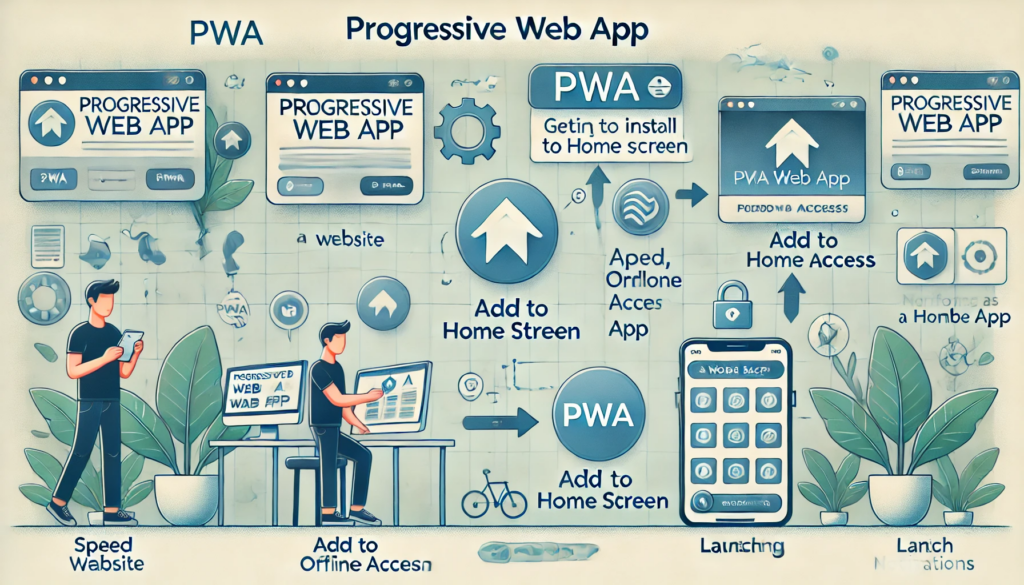
In summary, Progressive Web Apps represent a new frontier where websites function and feel more like native mobile applications than ever before. Backed by service workers, application manifests, and modern web APIs, PWAs have the power to operate in offline environments, send push notifications, load at remarkable speeds, and integrate seamlessly with various device features. The net result is a user experience that blurs the line between web and app, granting businesses a singular platform for broad reach and consistent delivery. While there may still be nuances in browser support or specialized native features, the trajectory is clear: with each passing year, PWAs climb nearer to full parity with native apps, fundamentally reshaping the digital ecosystem.
There has never been a better time to jump on the PWA train. Whether you’re planning a new product launch or seeking to revitalize an existing platform, Progressive Web Apps can help you meet user demands, streamline development, and widen your market. From an economic standpoint, a well-built PWA can result in lower overhead and fewer complications down the line. From a user standpoint, the immediate and engaging nature of PWAs checks all the boxes for modern expectations: speed, reliability, accessibility, and convenience.
To ensure your foray into PWAs is a resounding success, look no further than Vadimages. Our commitment to high-quality solutions and meticulous attention to detail ensures that your users receive the best possible experience every time they open your PWA. Whether it’s designing an elegant interface, configuring the offline cache, or enabling powerful push notifications, we have the expertise to guide your project from concept to completion. By harnessing the potential of Progressive Web Apps, you stand at the forefront of digital innovation, ready to deliver near-native experiences that captivate and retain your audience. The future of the web is here, and it is brimming with opportunities for those bold enough to seize them. Let Vadimages help you take the leap and shape a digital experience that will set your brand apart for years to come.


